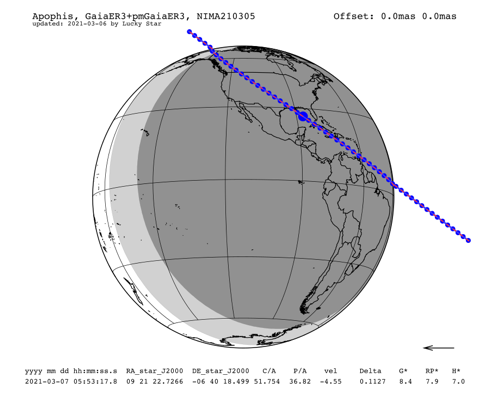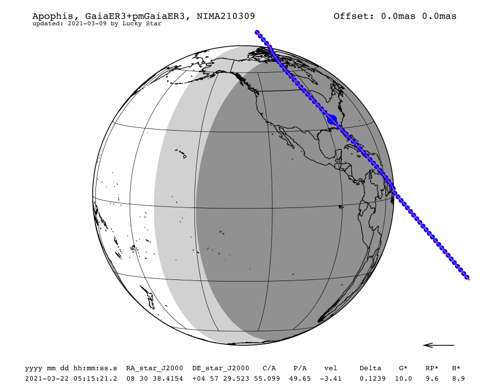Apophis, an Earth-crossing asteroid, fascinates both scientists and public since it regularly encounters the Earth. It has passed at 16.8 millions km in March 2021, and in April 2029 it will come as close as 31000 km to the Earth surface (12 times closer than Moon). Its trajectory is thus under close surveillance since its discovery in 2004.
For the first time, two stellar occultations by Apophis have been observed in the USA. This success is the result of a collaboration involving P.Tanga (Laboratoire Lagrange-Observatoire de la Côte d’Azur/UCA/CNRS), K. Tsiganis (Univ. Thessaloniki, Greece), Federica Spoto (Minor Planet Center, USA), J. Desmars (IMCCE/IPSA/Obs.Paris), D. Souami and B. Sicardy (LESIA/Obs.Paris), B.Morgado (Obs.Nacional et LIneA, Brasil), F. Braga-Ribas (UTFPR, Brésil), K. Tsiganis (Univ. Thessaloniki, Greece), in partnership with several American teams of professional and amateur astronomers.
 |
 |
Apophis occultation prediction charts for March 7th (left) and March 22th 2021 (right). Blue dots on the trajectory are spaced every minute. The grey zone represents the Earth at night
Stellar occultations are short events during which a star is hidden by an asteroid, as seen from an observer on Earth. They allow not only to determine the size and shape of small bodies in the solar system with a sub-km precision, but also to give their extremely precise positions. Occultation predictions require however a very accurate knowledge of the body movement and of the star position, and also a dense telescope network along the occultation path. In the case of Apophis (about 380 m diameter), such position accuracy is equivalent to the size of a 1-Euro coin at a distance of 1000 km! This would have been impossible to reach without the precision of Gaia catalogue and the expertise of the international team preparing the observations. Also, at the beginning of March, radar measurements have been fundamental to improve the orbit precision. Finally, the participation of amateur astronomers, equipped with mobile telescopes has been once more essential for the success of these observations.
The first occultations by Apophis, of a duration less than 0.1 second, have been registered by small telescopes on March 7 and 22, thus strongly improving its orbit and allowing further successful detections on April 4 and 10. Apophis becomes the first object of only a few hundred meters in size observed by stellar occultation. The deduced positions are complementary and equivalent in precision to the radar observations, with the advantage of being less expensive.
Beyond contributing to rule out every impact risk over the 100 next years, these observations have allowed us to measure the very weak acceleration caused by the Yarkovsky effect. This very small acceleration produced by the thermal emission of the asteroid, plays a major role in its dynamics and its trajectory during future close encounters with Earth. The scientific implications of the application of stellar occultations are thus enormous.
The success of these occultations opens a new era in the study of Earth-crosser asteroids. After the stellar occultations by the Earth-crosser Phaeton (around 6 km diameter) observed successfully in 2019 and 2020, and the recent occultations by Apophis in March 2021, we can henceforth consider occultations by other asteroids such as Didymos, another Earth-crosser, target of the DART (NASA) and Hera (ESA) missions.
Further information
https://www.cosmos.esa.int/web/gaia/iow_20210329
https://asteroid-obs.oca.eu/foswiki/bin/view/Main/OccultationAstrometry
Contacts
- Paolo Tanga - paolo.tanga@oca.eu
- Josselin Josselin Desmars - josselin.desmars@obspm.fr
- Damya Souami - damya.souami@obspm.fr
- Bruno Sicardy - bruno.sicardy@obspm.fr
- Kleomenis Tsiganis - tsiganis@auth.gr






